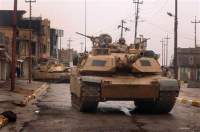US to begin training Ukrainian troops on Abrams tanks.

RAMSTEIN AIR BASE, Germany (AP) — The United States will begin training Ukrainian forces on how to use and maintain Abrams tanks in the coming weeks as it continues to speed up its effort to get them onto the battlefield as quickly as possible, U.S. officials said Friday.
The decision comes as defense leaders from around Europe and the world are meeting at Ramstein Air Base in the ongoing effort to coordinate the delivery of weapons and other equipment to Ukraine. An announcement is expected later Friday.
According to the officials, 31 tanks will arrive at Grafenwoehr Training Area in Germany at the end of May, and the troops will begin training a couple of weeks later. Officials said the troop training will last about 10 weeks. The training tanks will not be the ones given to Ukraine for use in the war against Russia. Instead, 31 M1A1 battle tanks are being refurbished in the United States, and those will go to the frontlines when they are ready.
The goal has been to have the troops trained by the time the refurbished tanks are ready so they can then immediately move to combat. The tanks are being refitted to meet Ukraine’s needs.
According to officials, about 250 Ukrainian troops will be trained — with some learning to operate the tanks and others learning to repair and maintain them. Additional training on how to fight and maneuver with the tanks could also be provided after the initial 10 weeks. The officials spoke on the condition of anonymity to provide details not publicly released.
So far, the U.S. has trained 8,800 Ukrainian troops who have already returned to the battlefield, and another roughly 2,500 are in training now. Their training has included everything from basic weapons instruction to how to conduct combat operations and how to maintain and repair equipment.
President Joe Biden’s administration announced in January that it would send Abrams tanks to Ukraine — after insisting for months that they were too complicated and too hard to maintain and repair. The decision was part of a broader political maneuver that opened the door for Germany to announce it would send its Leopard 2 tanks to Ukraine and allow Poland and other allies to do the same.
Under intense pressure from Ukraine and others to get the tanks into Ukraine faster, the Biden administration announced last month that it would speed up the delivery of Abrams tanks to Ukraine, opting to send a refurbished older model that can be ready faster. The goal is to get the 70-ton battle powerhouses to the war zone by the fall.
The U.S. also made clear at the time that it would begin training Ukrainian forces on how to use, maintain and repair the tanks and that the instruction would coincide with the refurbishment of the tanks so that both would be ready for battle at the same time later this year.
At the same time, the Pentagon must make sure that Ukrainian forces have an adequate supply chain for all the parts needed to keep the tanks running.
The Russian and Ukrainian forces have been largely in a stalemate, trading small slices of land over the winter. The fiercest battles have been in the eastern Donetsk region, where Russia is struggling to encircle the city of Bakhmut in the face of dogged Ukrainian defense. But both sides are expected to launch more intensive offensives in the spring.
Britain’s Ministry of Defense said Friday in its daily military assessment of the war the soft ground conditions and mud across most of Ukraine will likely slow operations for both sides in the conflict.
In other developments, Mykola Oleschuk, commander of Ukraine’s Air Forces, said Friday he had visited a U.S.-made Patriot missile system deployed on the battlefield after its recent delivery. Ukrainian officials announced on Wednesday that the Patriots had arrived.
Russia attacked Ukraine overnight with Iranian-made self-exploding Shahed drones, the Ukrainian military said Friday. Russia launched about 10 drones at Ukraine targets, and eight of them were shot down by Ukrainian air defenses, Ukraine’s General Staff said.
At least six civilians have been killed and six more have been wounded in Ukraine over the past 24 hours, Ukraine’s presidential office reported on Friday morning. According to Ukrainian officials, Russian shelling and missile strikes mostly targeted cities and villages in the embattled partially occupied regions of Donetsk, Zaporizhzhia, and Kherson. Outside of these regions, the Russian forces also attacked the Chernihiv province on Thursday with mortars. Overnight, Russia launched drones to attack Kyiv, as well as the Poltava and Vinnytsia regions.
Read the full article here:




